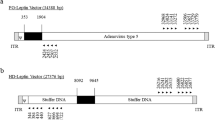Abstract
Intravenous administration of adenoviral vectors results mostly in hepatocyte transduction and subsequent hepatotoxicity. Because hepatocytes express high levels of the primary adenovirus receptor CAR, untargeting hepatocytes requires CAR-binding ablation. The amino acid residues of the viral fiber responsible for CAR-binding are known. We have constructed a mutant adenoviral vector unable to bind CAR and studied vector biodistribution and hepatotoxicity after intravenous administration. In contrast to a vector with wild-type fiber, the infectivity of the CAR-ablated vector is greatly reduced and not susceptible to inhibition with wild-type knob. Biodistribution and hepatotoxicity are, however, not affected by CAR-binding ablation. A possible explanation could be related to an increased blood persistence detected for the CAR-ablated vectors combined with their residual infectivity through other receptors.
This is a preview of subscription content, access via your institution
Access options
Subscribe to this journal
Receive 12 print issues and online access
$259.00 per year
only $21.58 per issue
Buy this article
- Purchase on Springer Link
- Instant access to full article PDF
Prices may be subject to local taxes which are calculated during checkout






Similar content being viewed by others
References
Muruve DA, Barnes MJ, Stillman IE, Libermann TA . Adenoviral gene therapy leads to rapid induction of multiple chemokines and acute neutrophil-dependent hepatic injury in vivo Hum Gene Ther 1999 10: 965–976
Dmitriev I et al. An adenovirus vector with genetically modified fibers demonstrates expanded tropism via utilization of a coxsackievirus and adenovirus receptor-independent cell entry mechanism J Virol 1998 72: 9706–9713
Haisma HJ et al. Targeting of adenoviral vectors through a bispecific single-chain antibody Cancer Gene Ther 2000 7: 901–904
Wickham TJ . Targeting adenovirus Gene Therapy 2000 7: 110–114
Roelvink PW et al. Identification of a conserved receptor-binding site on the fiber proteins of CAR-recognizing adenoviridae Science 1999 286: 1568–1571
Fechner H et al. Expression of Coxsackie adenovirus receptor and alphav-integrin does not correlate with adenovector targeting in vivo indicating anatomical vector barriers Gene Therapy 1999 6: 1520–1535
Alemany R, Suzuki K, Curiel DT . Blood clearance rates of adenovirus type 5 in mice J Gen Virol 2000 81: 2605–2609
Douglas JT et al. A system for the propagation of adenoviral vectors with genetically modified receptor specificities Nat Biotechnol 1999 17: 470–475
Legrand V et al. Fiberless recombinant adenoviruses: virus maturation and infectivity in the absence of fiber J Virol 1999 73: 907–919
O'Carroll SJ et al. Quantifying adenoviral titers by spectrophotometry Biotechniques 2000 28: 408–410, 412
Mittereder N, March KL, Trapnell BC . Evaluation of the concentration and bioactivity of adenovirus vectors for gene therapy J Virol 1996 70: 7498–7509
Hong SS et al. Adenovirus type 5 fiber knob binds to MHC class I alpha2 domain at the surface of human epithelial and B lymphoblastoid cells EMBO J 1997 16: 2294–2306
Dechecchi MC, Tamanini A, Bonizzato A, Cabrini G . Heparan sulfate glycosaminoglycans are involved in adenovirus type 5 and 2-host cell interactions Virology 2000 268: 382–390
Paielli DL et al. Evaluation of the biodistribution, persistence, toxicity, and potential of germ line transmission of a replication-competent human adenovirus following intraprostatic administration in the mouse Mol Ther 2000 1: 263–274
Christ M et al. Modulation of the inflammatory properties and hepatotoxicity of recombinant adenovirus vectors by the viral E4 gene products Hum Gene Ther 2000 11: 415–427
Worgall S, Wolff G, Falck-Pedersen E, Crystal RG . Innate immune mechanisms dominate elimination of adenoviral vectors following in vivo administration Hum Gene Ther 1997 8: 37–44
Huard J et al. The route of administration is a major determinant of the transduction efficiency of rat tissues by adenoviral recombinants Gene Therapy 1995 2: 107–115
Wood M et al. Biodistribution of an adenoviral vector carrying the luciferase reporter gene following intravesical or intravenous administration to a mouse Cancer Gene Ther 1999 6: 367–372
Walter I et al. Rapid and sensitive detection of enhanced green fluorescent protein expression in paraffin sections by confocal laser scanning microscopy Histochem J 2000 32: 99–103
Tao N et al. Sequestration of adenoviral vector by Kupffer cells leads to a nonlinear dose response of transduction in liver Mol Ther 2001 3: 28–35
Hegenbarth S et al. Liver sinusoidal endothelial cells are not permissive for adenovirus type 5 Hum Gene Ther 2000 11: 481–486
Lieber A et al. The role of Kupffer cell activation and viral gene expression in early liver toxicity after infusion of recombinant adenovirus vectors J Virol 1997 71: 8798–8807
Zsengeller Z et al. Internalization of adenovirus by alveolar macrophages initiates early proinflammatory signaling during acute respiratory tract infection J Virol 2000 74: 9655–9667
Dmitriev I et al. Ectodomain of coxsackievirus and adenovirus receptor genetically fused to epidermal growth factor mediates adenovirus targeting to epidermal growth factor receptor-positive cells J Virol 2000 74: 6875–6884
Acknowledgements
We are indebted to Joanne Douglas, Toshiro Seki, Igor Dmitriev, and Victor Krasnykh for providing valuable material. We are grateful to Baogen Lu and Kaori Suzuki for technical assistance. We thank Cristina Balague for critical reading of the manuscript and Paul Reynolds for helpful discussions. This work was supported by grants R01 HL50255, R01 CA74242, R01 CA83821, R01 CA8688–01, N01 CO-97110, P50 CA83591, P50 CA89019, U19 DK57858, and the Juvenile Diabetes Foundation.
Author information
Authors and Affiliations
Rights and permissions
About this article
Cite this article
Alemany, R., Curiel, D. CAR-binding ablation does not change biodistribution and toxicity of adenoviral vectors. Gene Ther 8, 1347–1353 (2001). https://doi.org/10.1038/sj.gt.3301515
Received:
Accepted:
Published:
Issue Date:
DOI: https://doi.org/10.1038/sj.gt.3301515
Keywords
This article is cited by
-
Preferential expression of SCN1A in GABAergic neurons improves survival and epileptic phenotype in a mouse model of Dravet syndrome
Journal of Molecular Medicine (2023)
-
Sstr2A: a relevant target for the delivery of genes into human glioblastoma cells using fiber-modified adenoviral vectors
Gene Therapy (2013)
-
A myeloid cell-binding adenovirus efficiently targets gene transfer to the lung and escapes liver tropism
Gene Therapy (2013)
-
Adenovirus i-Leader Truncation Bioselected Against Cancer-associated Fibroblasts to Overcome Tumor Stromal Barriers
Molecular Therapy (2012)



